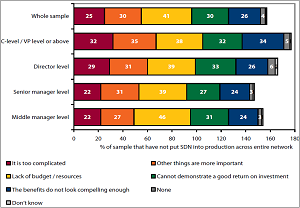News
Avaya Takes SDN to the Edge
Avaya Inc. today unveiled a new software-defined networking (SDN) architecture, building on its fabric-based networking technologies.
"The Avaya Open SDN Fx architecture is the first to deliver automation and programmability from the network core to the user edge, for 'connect anything, anywhere' simplicity," the company said in a statement.
At Avaya, better known for collaboration and communication technologies, networking fabric-speak, the network "edge," has a somewhat atypical meaning.
"The 'edge,' in this case, is not to be understood as the typical network edge (device) but as the place where the network meets the application, that is, a hypervisor supporting multiple application virtual machines (VMs) or Docker containers, an edge voice application device (also known as a phone) or devices purpose-built as SDN edge devices," said company exec Andrew Rufener in a blog post earlier this month where he explained "Why the Best Foundation for SDN Is an Enterprise-Wide Automated Core."
That "automated core" is one of the three main characteristics of the SDN Fx architecture, along with an open ecosystem and "an enabled edge that leverages fabric extension beyond the datacenter to the user edge."
 [Click on image for larger view.]
Barriers to Full Adoption of SDN (source: Avaya Inc.)
[Click on image for larger view.]
Barriers to Full Adoption of SDN (source: Avaya Inc.)
Avaya said in a statement that the automated core "takes advantage of a single, network-wide Ethernet fabric to remove the need for manual configuration at each network hop; thus, reducing the potential for error and accelerating time to service."
Three new components are supplying the bedrock technology for the new architecture: an Open Networking Adapter (ONA), a Fabric Orchestrator and Fabric Extend, which facilitates the ability to extend Fabric networking over IP-based networks without losing any functionality.
The ONA is a plug-n-play device about the size of a deck of cards that users can plug in to automatically provision a virtual path through the network for increased security and easier device management.
The Fabric Orchestrator controls the Ethernet fabric and provides control of SDN northbound and southbound interfaces. It can work with OpenFlow, OpenDaylight and OpenStack technologies.
Avaya exec Marc Randall said his company's new approach is better than those of some competitors who use an overlay approach to inject SDN functionality into existing networks. VMware Inc., Juniper Networks Inc. and Nuage Networks are some of the prominent SDN vendors with overlay approaches.
"They add another protocol, another layer of software, possibly another layer of hardware -- all of which further burdens the network," Randall said in a blog post today. "What you have is akin to Jenga, whereby one wrong move topples an increasingly precarious stack of blocks. Imagine if you had to manually remove and replace each of those blocks before finally selecting the one piece that would let you move to the next level -- or not."
Providing further evidence for the need for a new approach, Avaya published the results of a recent independent survey it commissioned, wherein it stated, "Almost all IT professionals in large companies (99 percent) think it is important to some degree that SDN models are able to extend SDN capabilities beyond the datacenter and across the entire enterprise." However, the survey said, "93 percent feel today's SDN models are actually limited in this respect."
Randall said that while it may appear Avaya is coming late to the SDN party, the timing actually couldn't be better.
"With SDN Fx, we're enabling IT to connect anything, anywhere," Randall said. "Our Avaya Fabric Connect technology on which our SDN Fx architecture is built, already solves the top five issues that IT professionals are seeking from SDN solutions. With today's announcement, we're now enabling automation and programmability all the way to the user edge -- without unnecessary overlays, boxes and protocols."
About the Author
David Ramel is an editor and writer at Converge 360.